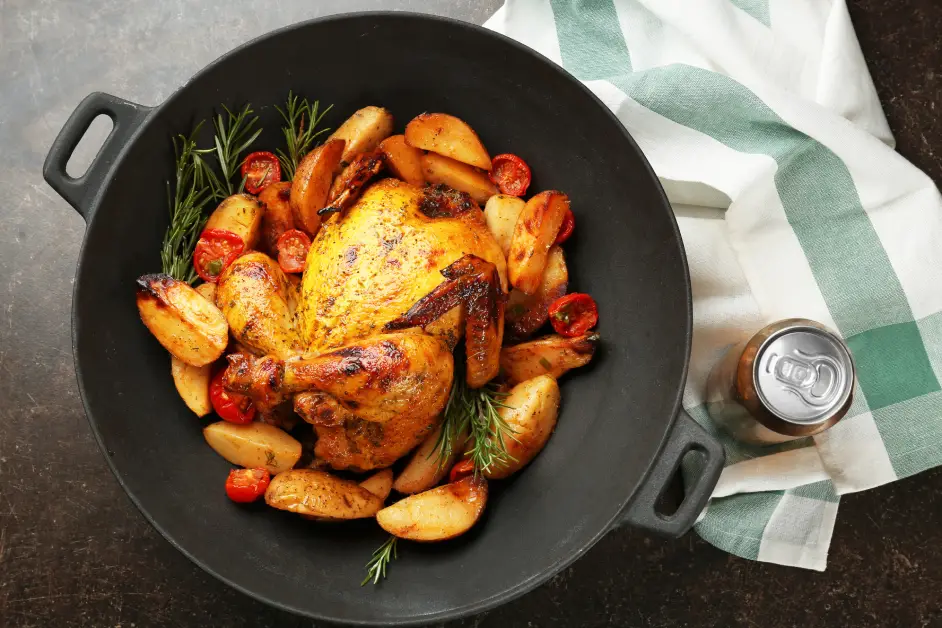
Introduction to Chicken of the Woods Recipe
What is Chicken of the Woods?
Chicken of the Woods Recipe! Not your typical poultry, but a vibrant wild mushroom, scientifically known as Laetiporus sulphureus. This culinary delight, often found on oak trees, is a forager’s dream. It’s a sustainable choice for those exploring forest-to-table cuisine, offering a meaty texture and a flavor akin to chicken.
Nutritional Benefits
Now, let’s talk health! Chicken of the Woods Recipe isn’t just a tasty treat; it’s packed with nutritional goodness. This mushroom is a treasure trove of plant-based protein, making it a fantastic option for those on a vegan or vegetarian diet. Furthermore, it’s low in calories and fat, yet rich in essential nutrients. We’re talking vitamins, minerals, and antioxidants that are crucial for maintaining a healthy body. And guess what? Studies, such as those highlighted in Healthline’s article on the health advantages of mushroom consumption, have shown that mushrooms like Chicken of the Woods can boost your immune system and even improve heart health. How’s that for a superfood?
In the next section, we’ll dive into the nitty-gritty of selecting and preparing these woodland wonders. Consequently, stay tuned for some top-notch tips that’ll turn you into a Chicken of the Woods connoisseur in no time!
Selecting and Preparing Chicken of the Woods Recipe
How to Identify and Harvest
Venturing into the woods to forage for Chicken of the Woods can be an exciting endeavor. However, it’s crucial to know exactly what you’re looking for. This mushroom typically grows on dead or dying hardwood trees, such as oaks and cherries. You’ll recognize it by its shelf-like structure and vibrant orange and yellow colors. But beware, as there are look-alikes! Always consult a reliable guide or a seasoned forager to ensure you’ve got the real deal.
Once you’ve found your prize, harvesting is straightforward. Use a knife to gently cut the mushroom from the tree, taking care not to damage the tree or the fungus’s growing area. This sustainable approach ensures that the mushroom can continue to grow and be harvested in the future.
Cleaning and Storage Tips
After the thrill of the hunt, it’s time to prepare your Chicken of the Woods for the kitchen. First things first, give it a good cleaning. Brush off any debris or dirt gently. It’s usually best to avoid washing mushrooms with water as they can become soggy, but if necessary, a quick rinse and pat dry will do.
When it comes to storage, mushrooms are best used fresh. However, if you need to store them, wrap them in paper towels and place them in a paper bag in the refrigerator. This method helps to absorb any excess moisture, keeping your mushrooms fresh for a few days.
In the upcoming section, we’ll explore various cooking techniques to transform this wild mushroom into delectable dishes. So, get ready to turn your foraged finds into culinary masterpieces!
Cooking Techniques for Chicken of the Woods Recipe
Sautéing and Frying
One of the most popular ways to cook Chicken of the Woods is by sautéing or frying. These methods bring out the mushroom’s natural flavors and create a delightful texture. To sauté, simply heat some oil or butter in a pan, add sliced mushrooms, and cook until they’re golden brown. You can enhance the flavor with garlic, onions, or your favorite herbs. For frying, consider a light batter or breadcrumb coating. This technique gives the mushrooms a crispy exterior, perfect for a meat-free alternative in dishes like stir-fries or tacos.
Grilling and Baking
If you’re aiming for a smokier flavor, grilling Chicken of the Woods is a fantastic option. Brush the mushrooms with oil, season them as desired, and grill them until they’re tender and charred. This method is ideal for summer barbecues or outdoor cooking. Baking, on the other hand, is a healthier option that still yields delicious results. Marinate the mushrooms in your favorite sauce or seasoning, then bake them until they’re tender. This method works wonderfully for creating meatless dishes like “chicken” pot pie or casseroles.
Incorporating into Soups and Stews
Chicken of the Woods can also be a star ingredient in soups and stews. Its meaty texture holds up well in liquid and absorbs flavors beautifully. Add chopped mushrooms to your favorite vegetable soup or stew recipe, and let them simmer until tender. They add a hearty element to any dish, making them a perfect addition to your winter comfort food recipes.
Recipe Ideas
Breakfast Dishes
Kickstart your day with a twist on classic breakfast dishes using Chicken of the Woods. Imagine a hearty mushroom hash, where the mushrooms are sautéed with potatoes, onions, and bell peppers, offering a perfect blend of flavors and textures. Or, how about a vegan-friendly scramble? Substitute traditional eggs with crumbled tofu, add diced Chicken of the Woods, and season with turmeric, nutritional yeast, and your favorite herbs for a delicious and nutritious start to your day.
Main Courses
For main courses, Chicken of the Woods shines in a variety of dishes. A vegan twist on the classic chicken parmesan can be created by coating the mushrooms in a crispy breadcrumb mixture, baking them to perfection, and serving with marinara sauce and vegan cheese. Another delightful option is a creamy mushroom risotto, where the Chicken of the Woods adds a meaty texture and absorbs the rich flavors of the broth and herbs, making it a satisfying and elegant dish.
Side Dishes and Appetizers
As for side dishes and appetizers, these mushrooms can be transformed into delightful small bites. Think of stuffed mushrooms, where the caps of Chicken of the Woods are filled with a mixture of breadcrumbs, garlic, parsley, and vegan cheese, then baked until golden. Or, create a simple yet flavorful mushroom bruschetta, topping toasted slices of crusty bread with sautéed Chicken of the Woods, garlic, and fresh basil.
Vegan and Vegetarian Options
The versatility of Chicken of the Woods also extends to vegan and vegetarian options. A vegan “chicken” noodle soup, where the mushrooms replace chicken, can provide comfort on any chilly day. Additionally, a vegetarian stir-fry featuring Chicken of the Woods, a variety of colorful vegetables, and a savory sauce can be a quick and healthy meal, perfect for busy weeknights.
Health and Dietary Considerations
Nutritional Profile
Chicken of the Woods Recipe isn’t just a culinary delight; it’s also a nutritional powerhouse. This mushroom is an excellent source of plant-based protein, making it a fantastic choice for vegetarians and vegans. Additionally, it’s low in calories and fat but high in fiber, which is great for digestion. It also packs a punch with vitamins and minerals, including Vitamin C, Vitamin D, potassium, and more. These nutrients are essential for maintaining overall health, supporting everything from immune function to bone health.
Allergies and Sensitivities
While Chicken of the Woods Recipe is generally considered safe and healthy to eat, it’s important to be aware of potential allergies and sensitivities. Some individuals may experience mild reactions, especially if they are new to foraged mushrooms or have sensitivities to other fungi. It’s always a good idea to try a small amount first to see how your body reacts. Additionally, those with specific dietary restrictions or health conditions should consult with a healthcare provider before incorporating new types of mushrooms into their diet.
Frequently Asked Questions
Best Ways to Eat Chicken of the Woods Recipe
One common question is about the best ways to enjoy Chicken of the Woods. This versatile mushroom can be cooked in various ways, each bringing out its unique flavor and texture. Sautéing in a bit of olive oil with garlic and herbs is a simple yet delicious method. It’s also fantastic when grilled, giving it a smoky flavor that’s perfect for summer barbecues. For those who love experimenting, incorporating it into soups, stews, or even baking it into savory pies can be delightful. The key is to cook it thoroughly to bring out its naturally rich, umami flavor.
Common Mistakes and Lookalikes
Another important consideration is identifying Chicken of the Woods correctly to avoid mistaking it for other similar-looking mushrooms. It’s crucial to note that Chicken of the Woods grows on wood, typically on dead or dying trees, and has a bright orange to yellow color. Mistaking it for other species, like the toxic Jack O’Lantern mushroom, which grows on the ground and has gills, can be dangerous. Always forage with an experienced guide or use reliable resources to ensure correct identification.
Health Benefits
Many are curious about the health benefits of Chicken of the Woods. This mushroom is not only a great meat substitute but also offers numerous health benefits. It’s a low-calorie, high-protein option, making it ideal for weight management. The mushroom is also rich in antioxidants, which help combat free radicals and support overall health. Additionally, its fiber content aids in digestion and promotes gut health.
Pre-soaking Requirements
Finally, a common query is whether Chicken of the Woods needs to be soaked before cooking. Generally, it’s not necessary to soak these mushrooms. However, if they are particularly dirty or have a lot of debris, a quick rinse and pat dry can be done. Soaking can make them waterlogged and affect their texture. It’s best to clean them gently with a brush or a damp cloth to maintain their integrity.
Conclusion
Summary of Cooking with Chicken of the Woods Recipe
As we wrap up our journey through the world of Chicken of the Woods, let’s revisit the key takeaways. This unique mushroom is not only a culinary gem but also a nutritional powerhouse, offering a versatile and healthy alternative to meat. Its ability to adapt to various cooking methods – from sautéing to grilling, and even baking – makes it a favorite in the kitchens of both amateur cooks and professional chefs. The rich, umami flavor and meaty texture of Chicken of the Woods can elevate any dish, making it a standout ingredient in vegan and vegetarian cuisine.
Moreover, its health benefits, including being a source of plant-based protein, vitamins, and antioxidants, add to its appeal. While it’s important to forage responsibly and be aware of look-alikes, the culinary rewards of Chicken of the Woods are well worth the effort. Whether you’re a seasoned forager or a curious food enthusiast, this mushroom offers a world of possibilities to explore and enjoy.
In conclusion, Chicken of the Woods is more than just a mushroom; it’s a testament to the wonders of nature and the joys of cooking with wild ingredients. So, the next time you come across this vibrant fungus, remember the tips and recipes from this article, and get ready to experience a delightful and healthful culinary adventure!




